Home » More Paper & Pencil Games
More Pencil & Paper Games
I came across Ben Orlin’s blog post dealing with pen-and-paper games. I was immediately drawn in and began trying them at home and quickly introduced them to my grade three students in our daily online math meet ups.
Students enjoyed them thoroughly leaving them wanting more and that is when my search began. I searched through several older books containing math games and logic puzzles. In my search I came across these wonderful books:
A Gamut of Games by Sid Jackson
Games with Paper and Pencil by Eric Solomon
Mathematical Fun, Games and Puzzles by Jack Frohlichstein
I pulled out 4 pencil-and-paper games to share with you, one of which Ben shared earlier this year from A Gamut of Games. My students and I have thoroughly enjoyed them, and I hope you do too. Enjoy!
1. Hold that line by sid jackson
A game for two players that involves taking turns drawing straight lines on 4 by 4 dot gameboard. Do not be the last player forced to make the last line.
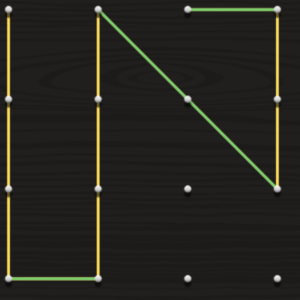
Ben Orlin does an excellent job explaining this game in his January 9th blog posts of this year.
2. cutting corner by sid jackson
Players: 2 players
Materials:
A piece of paper where a large enough square can be drawn.
Two different coloured pens.
Goal: To be the player with the higher total number of sections after 6 lines are drawn (3 by each player).
How to Play
1. Begin by drawing a large enough square with two adjacent sides one colour and the remaining 2 sides the second colour.

2. The first player (blue pen), starts at one edge and draws a line, making on right-angle turn, and ends at another edge. At least one of the edges connected must be of the opponent’s color.


3. The second player draws a similar line between two edges, making one crossing. From here on out all lines must either cross at least one line of the opposite color or must terminate in at least one edge of the opposite color.
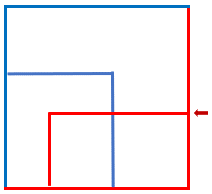
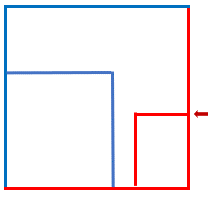
4. Player one draws their second line.

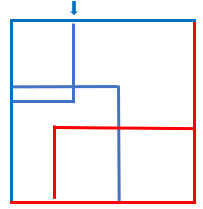
5. Play continues as follows
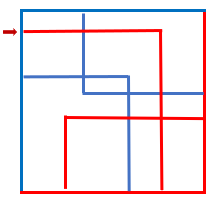



Scoring:
The original square has now been divided into 24 sections.
A section is won by a player if they have more sides of their colour around it than their opponent. Ex) the lower left “L” shaped section has 4 sides coloured red and 2 sides coloured blue. This section therefore belongs to red and places a red “x” in the section.
If the sides are equally divided, it belongs to neither player and a black dot is placed in that section.
The final diagram shows the second player (red) winning 8 sections the first player (blue) winning 7 sections, and 9 sections (black dot) being tied. All adding up to 24 which is the amount of sections that were created (easy way to ensure no mistakes were made).
The player with the higher total number of sections is the winner.
3.boxes shared by eric solomon
Players: 2 players
Materials:
Dots game sheet (odd number of squares is preferred)
Pencil
Goal: To win the greater number of boxes.
How to Play:
Players take turns drawing one horizontal or one vertical line connecting two adjacent and previously unconnected dots.
A box is won by the player who draws the fourth and last side of the box.
After a player has won a box, they immediately take another turn (if they complete two boxes simultaneously with one line, they only take one additional turn).


Scoring:
When all the lines are drawn, and boxes are marked then you can count which player has won the most squares.
The game below has player A with 42 boxes and player B with 39 boxes, therefore player A wins by 3.

Since playing Boxes with my class I have come to learn that this game was first published in the 19th century by French Mathematician Edouard Lucas who called it la pipopipette and has gone by many other names including game of dots, dot to dot grid, pigs in a pen and dots and boxes. Dan Finkel talks about Dots and Boxes in his blog post from 2016.
Boxes or Dots and Boxes can be played online at the following link.
4."no lift" by jack frohlichstein
In Mathematical Fun, Games and Puzzles this game is referred to it as “Game NO. 19”. Our class decided to give Jack’s game the name “No Lift”.
Players: 2 players
Materials:
-
4 by 5 dot board
-
Pencil
Goal: Complete as many whole squares as possible, never taking the pencil off the paper.
How to Play:
-
Start at any place and connect each dot, completing as many squares as possible.
-
You may not retrace or cross any previously made line.
-
When you cannot move anymore, the game is finished
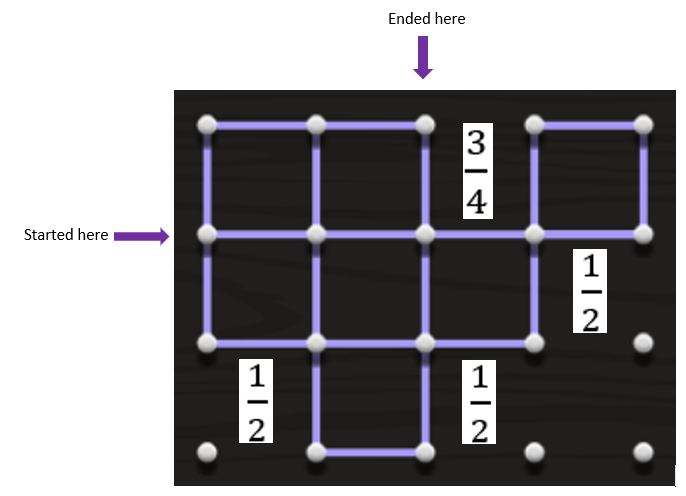

Scoring
For every square completed you receive one point.
If you have 3 sides of a square complete you receive
Two sides of a square counts as , and 1 side of a square counts as
Variation:
More Dots: The game is the same except it is played on a 5 by 5 dot board.
Facebook
Twitter
